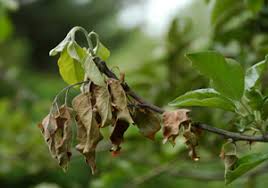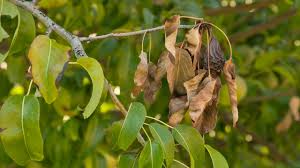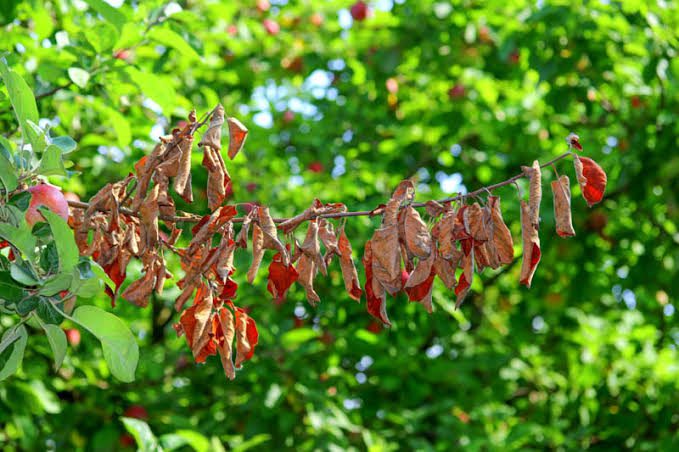Fire blight (rosaceae family) is a destructive bacterial disease that affects plants in the Rosaceae family and its scientific name is Erwinia amylovora. This disease primarily targets fruit trees, such as apple and pear trees, as well as other ornamental plants within the Rosaceae family.
The bacterium responsible for fire blight, Erwinia amylovora, thrives in warm and humid conditions, making it particularly problematic in certain regions and during specific seasons. This disease poses a significant threat to orchards and gardens, as it can lead to severe economic losses due to crop damage.
One of the distinctive features of fire blight is the rapid wilting and blackening of affected plant tissues, resembling the aftermath of a fire – hence the name “fire blight.” The bacterium infects blossoms, shoots, and branches, causing a characteristic scorched appearance. This visible damage often spreads quickly through the plant, contributing to its destructive nature.
The bacteria enter the plant through natural openings, such as nectar glands or wounds, and subsequently move through the vascular system. Once inside, Erwinia amylovora multiplies and produces toxins that lead to the wilting and blackening of plant tissues. The disease can spread through rain, wind, or insects, further facilitating its rapid transmission.
To manage and control fire blight, various strategies are employed. These include pruning infected branches to reduce the spread of the bacteria, applying antibacterial sprays during the growing season, and implementing cultural practices to minimize conditions conducive to bacterial growth. Additionally, planting resistant varieties can be an effective preventive measure.
The impact of fire blight extends beyond the immediate crop loss, as it can also affect the long-term health and productivity of orchards and gardens. Farmers and horticulturists continually seek innovative approaches to combat this destructive disease and safeguard their crops from its detrimental effects.
Fire blight poses a significant threat to plants in the Rosaceae family, with apple and pear trees being particularly susceptible. The rapid spread of the disease, coupled with its characteristic scorched appearance, makes it a formidable challenge for farmers and gardeners. Effective management strategies, including pruning, antibacterial sprays, and the use of resistant varieties, are crucial in mitigating the impact of fire blight and preserving the health of orchards and gardens.
Read Also: Armillaria Root Rot: Description, Damages Caused, Control and Preventive Measures
Plants Affected by Fire Blight (Erwinia amylovora)

Fire blight (rosaceae family) primarily affects plants within the Rosaceae family. Among the most commonly affected plants are fruit-bearing trees and ornamental plants. Apple (Malus domestica) and pear (Pyrus spp.) trees are particularly susceptible to this bacterial disease, experiencing severe damage that can impact fruit production and overall tree health.
In addition to apple and pear trees, other members of the Rosaceae family can also be affected by fire blight. These may include various ornamental plants such as roses (Rosa spp.), spirea (Spiraea spp.), and hawthorn (Crataegus spp.). The ability of Erwinia amylovora to infect a broad range of plants within this botanical family contributes to the widespread concern among farmers, orchardists, and gardeners.
The bacterial infection targets blossoms, shoots, and branches, leading to characteristic symptoms such as wilting and blackening of affected tissues. The ease of transmission through natural openings, wounds, or even insect vectors further amplifies the risk of fire blight spreading within a plant community.
Efforts to manage and control fire blight involve not only addressing affected fruit trees but also implementing preventive measures for ornamental plants within the Rosaceae family. Pruning infected branches, applying antibacterial sprays, and selecting resistant plant varieties are essential components of a comprehensive strategy to mitigate the impact of fire blight across a diverse range of susceptible plants.
Damages Caused by Fire Blight

Fire blight (rosaceae family) inflicts significant damages on affected plants, particularly those within the Rosaceae family. The consequences of this bacterial disease are broad and can impact both economic and aesthetic aspects of plant cultivation.
1. Fruit Production: One of the most immediate and economically significant damages caused by fire blight is the reduction in fruit production. Apple and pear trees, being major targets of the disease, can experience a substantial decline in yield. The bacterial infection affects blossoms, leading to a failure in fruit set, and can also spread to young fruit, causing premature fruit drop.
2. Shoot and Branch Dieback: Fire blight causes a characteristic wilting and blackening of infected shoots and branches, resembling the aftermath of a fire. This dieback not only affects the current season’s growth but can also have long-term consequences for the overall structure and health of the plant.
3. Tree Mortality: In severe cases, fire blight can lead to the death of entire trees. The bacterial infection can progress rapidly, especially during warm and humid conditions, causing extensive damage to the vascular system and compromising the plant’s ability to sustain itself.
4. Aesthetic Impact: Beyond the economic losses, fire blight also has aesthetic consequences for ornamental plants within the Rosaceae family. Roses, spirea, and other ornamental members can suffer from the characteristic scorched appearance, diminishing their visual appeal and overall landscape value.
5. Secondary Infections: The weakened state of plants infected with fire blight makes them more susceptible to secondary infections by other pathogens. This further exacerbates the overall health decline of affected plants.
6. Cultural and Landscape Impact: Fire blight can have a lasting impact on agricultural practices and landscape design. Farmers and gardeners may need to adjust their cultivation practices, such as increased pruning and selection of resistant plant varieties, to mitigate the risk of future outbreaks.
Efforts to manage and control fire blight aim to minimize these damages through strategies like pruning, antibacterial sprays, and the use of resistant plant varieties. However, the pervasive nature of the disease and its ability to spread rapidly make it a challenging adversary for those cultivating plants in the Rosaceae family.
Read Also: Cercospora Leaf Spot: Description, Damages Caused, Control and Preventive Measures
Control and Preventive Measures

Controlling and preventing fire blight (rosaceae family) involves a combination of cultural practices, biological controls, and chemical interventions. These measures are crucial for minimizing the impact of the disease on plants within the Rosaceae family, especially fruit trees like apples and pears.
1. Pruning: Regular and timely pruning is a key control measure for fire blight. Infected branches should be pruned at least 12 inches below visible symptoms, making sure to sterilize pruning tools between cuts to prevent further spread of the bacteria.
2. Sanitation: Remove and destroy infected plant material promptly. This includes fallen leaves, pruned branches, and any other debris that may harbor the bacteria. Proper disposal helps reduce the bacterial load in the vicinity, limiting the chances of re-infection.
3. Resistant Varieties: Planting resistant varieties of fruit trees and ornamental plants within the Rosaceae family can be an effective preventive measure. Resistant cultivars have genetic traits that make them less susceptible to Erwinia amylovora, providing a natural defense against the disease.
4. Copper-Based Sprays: Copper-based bactericides are commonly used to control fire blight. These sprays are applied during the growing season to protect susceptible plants. However, they need to be used with caution, as excessive application can lead to phytotoxicity.
5. Streptomycin Applications: Antibiotics, such as streptomycin, are used to control fire blight by inhibiting the growth of Erwinia amylovora. These sprays are most effective when applied during the bloom period or when conditions are conducive to bacterial infection. However, their use should be judicious to prevent antibiotic resistance.
6. Avoiding Nitrogen-Rich Fertilizers: Excessive nitrogen fertilization can encourage lush, succulent growth that is more susceptible to fire blight. Balancing fertilizer applications to promote overall plant health without stimulating excessive growth is essential.
7. Monitoring and Early Detection: Regular monitoring of plants for symptoms and early detection of fire blight are crucial for effective control. Swift action, such as pruning infected parts, can help contain the spread of the disease.
8. Weather-Based Predictive Models: Utilizing weather-based predictive models can aid in anticipating conditions favorable for fire blight development. This allows for timely implementation of control measures during high-risk periods.
9. Biological Controls: Some beneficial bacteria and antagonistic microorganisms can compete with Erwinia amylovora for space and nutrients. Integrating biological controls into orchard or garden management can help suppress the growth of the fire blight-causing bacteria.
Implementing a combination of these control and preventive measures is key to managing fire blight effectively. Integrated pest management (IPM) strategies that consider the specific conditions of the orchard or garden are essential for sustainable and successful fire blight control.
Frequently Asked Questions (FAQs) About Fire Blight (Erwinia amylovora)
1. Q: What is fire blight?
A: Fire blight is a bacterial disease that affects plants in the Rosaceae family, causing wilting, blackening, and a scorched appearance in infected tissues.
2. Q: Which plants are susceptible to fire blight?
A: Fruit trees such as apple and pear trees are particularly susceptible. Other members of the Rosaceae family, including ornamental plants like roses and spirea, can also be affected.
3. Q: What is the scientific name of the bacterium causing fire blight?
A: The bacterium responsible for fire blight is called Erwinia amylovora.
4. Q: How does fire blight spread?
A: Fire blight can spread through rain, wind, or insect vectors. The bacterium enters plants through natural openings or wounds and moves through the vascular system.
5. Q: What are the symptoms of fire blight?
A: Symptoms include wilting, blackening of shoots and branches, and a scorched appearance. The infected plant parts often resemble the aftermath of a fire.
6. Q: Can fire blight lead to the death of plants?
A: Yes, in severe cases, fire blight can lead to the death of entire plants, especially during warm and humid conditions.
7. Q: How can I control and prevent fire blight?
A: Control measures include pruning infected branches, using antibacterial sprays, planting resistant varieties, and practicing proper sanitation. Regular monitoring and early detection are also crucial.
8. Q: Are there organic methods to control fire blight?
A: Yes, cultural practices like pruning, proper sanitation, and using biological controls are considered organic methods. Copper-based sprays can also be used, although their use should be carefully managed.
9. Q: When is the best time to apply control measures for fire blight?
A: Control measures, such as pruning and spraying, are often most effective when applied during the growing season, especially during the bloom period or when conditions favor bacterial infection.
10. Q: Can fire blight be transmitted from one plant to another?
A: Yes, fire blight can be transmitted through various means, including rain, wind, insects, and contaminated pruning tools. Proper sanitation practices can help minimize transmission.
11. Q: Are there resistant varieties of plants available?
A: Yes, there are resistant varieties of fruit trees and ornamental plants within the Rosaceae family. Planting these varieties can provide a natural defense against fire blight.
12. Q: What should I do if I suspect fire blight in my plants?
A: If you suspect fire blight, promptly prune and dispose of infected plant material, apply antibacterial sprays if necessary, and consider consulting with a horticulturist for guidance on control measures. Regular monitoring is essential for early detection.
